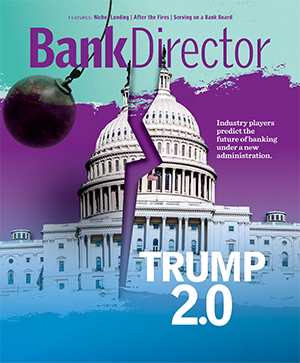Laura Alix is the Director of Research at Bank Director, where she collaborates on strategic research for bank directors and senior executives, including Bank Director’s annual surveys. She also writes for BankDirector.com and edits online video content. Laura is particularly interested in workforce management and retention strategies, environmental, social and governance issues, and fraud. She has previously covered national and regional banks for American Banker and community banks and credit unions for Banker & Tradesman. Based in Boston, she has a bachelor’s degree from the University of Connecticut and a master’s degree from CUNY Brooklyn College.

Stemming the Fraud Epidemic
Bank leaders named fraud as a top risk in Bank Director’s 2025 Risk Survey. Here’s how some financial institutions are tackling this growing problem.
Since 2021, staff at First Financial Bankshares in Abilene, Texas, have stopped over $22.6 million in fraud, estimates CEO and Chairman Scott Dueser. The $14 billion bank has done that by training workers to recognize and stop fraud before it happens. Executives also regularly honor frontline workers who catch fraud.
First Financial’s leadership team got more serious about fraud about 20 years ago, when executives realized the bank had loaned $20,000 to a customer who then sent those funds to a scammer. Still, Dueser says he couldn’t have predicted just how much fraud would multiply in both volume and type. “It’s an epidemic today,” he says.
A number of root causes underlie the explosion in fraud in the banking space, including the rise of cryptocurrency and international criminal organizations that are dedicated to scamming people via phone and text messaging. Bank Director’s 2025 Risk Survey finds fraud among bank executives’ and directors’ key concerns: 69% report fraud as a top five risk, behind cybersecurity (84%). Moreover, 94% say their bank or its customers have experienced check fraud over the prior 18 months. Seventy percent report financial abuse targeting elderly or otherwise vulnerable customers, and 61% have experienced digital payments fraud.
Fraudsters leverage myriad methods to trick customers. One common scam starts with a text message initiating contact with the target under the pretense of starting a relationship or recruiting for a job. Over time, the scammer builds trust before asking the victim to fund a phony investment, usually via cryptocurrency.
“The [scam] that every community financial institution is dealing with and feels powerless against is probably the romance scam,” says Todd Rovak, founder and co-CEO of the fintech firm Carefull. “Whether it’s romance flavored or investment scams, it all sits under this idea of relationship forming before you ask for money. The challenge for community financial institutions is they can’t see any of this.”
Columbus, Georgia-based Synovus Financial Corp. recently partnered with Carefull to implement fraud protections for certain checking account holders. A customer connects their accounts to Carefull, which uses artificial intelligence to scan for anomalous activity. Customers can set up trusted contacts, such as a family member, to receive alerts, and they can choose the level of visibility they want to allow those contacts to have into their affairs. The $60 billion bank includes the service as a benefit in some of its checking account products.
Synovus is also working to protect customers from another type of scenario, in which a fraudster will contact a customer and pretend to be a bank employee alerting that person to an attempt of fraud, says Liz Wolverton, head of consumer banking and brand experience at Synovus. The would-be thief weaves their requests for sensitive information into the conversation. “In the past, fraudsters have been more thieves in the night,” she says. “Now, they’re putting themselves in situations where we’re the most vulnerable and feel the most guarded, and they’re purporting to be the good guys.”
In a callback to “stop, drop and roll” fire safety campaigns, Synovus urges customers to “stop, drop and call” the bank when they’re asked for sensitive information such as login details, says Wolverton.
“The [customer’s] biggest fear is, ‘Wait a minute, if I miss my window here and it actually is fraud, what am I going to do?’” Wolverton says. “It’s almost like you have to give the customer permission that, if it is us and you [drop the call], it’s going to be OK.”
Among their efforts to fight fraud, bank leaders taking part in the 2025 Risk Survey most commonly report using ongoing staff education on the latest scams and threats (86%), improving staff training (82%) and regular communications to customers (70%).
Banks are also making use of laws in states that allow financial institutions to hold or deny suspicious transactions involving older or vulnerable customers. According to a recent survey of 158 banks by the American Bankers Association, 43% reported those laws had been effective in stopping elder financial abuse.
Over the years, First Financial has established contacts with local law enforcement and adult protective services as part of its broader fraud-fighting agenda. All bank staff are trained to recognize signs of fraud and financial exploitation, and every branch has a set protocol to follow when staff suspect fraud. Additionally, First Financial sends bank officers to churches, retirement centers and other civic organizations to speak on the subject.
Even with all those efforts, Dueser acknowledges that First Financial can’t stop every instance of fraud that might touch its customers. He believes bigger action will be needed to exert more control over the avenues commonly exploited by scammers, such as cryptocurrency. His bank has long been politically active, and with the benefit of hindsight, he would have begun lobbying his congressional representatives much earlier. “Too many people are losing way too many dollars,” he says.



